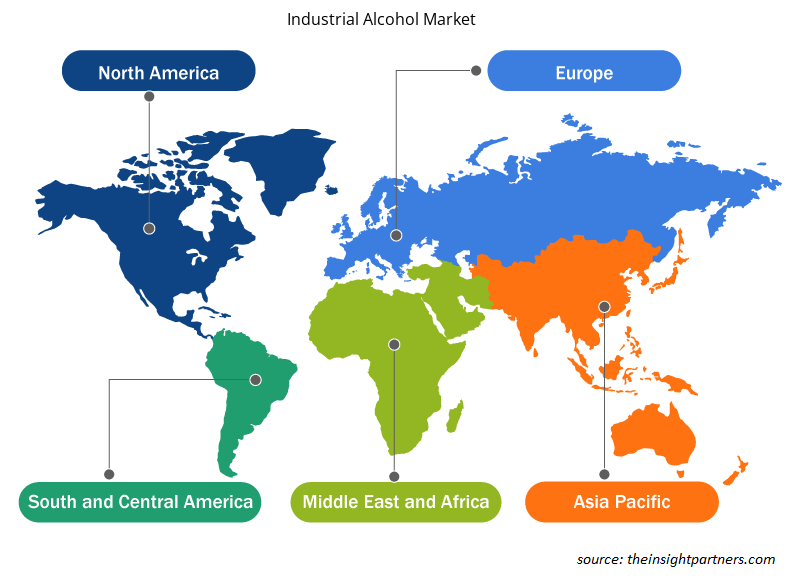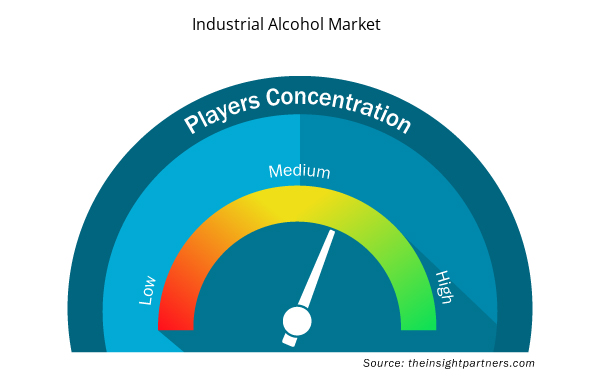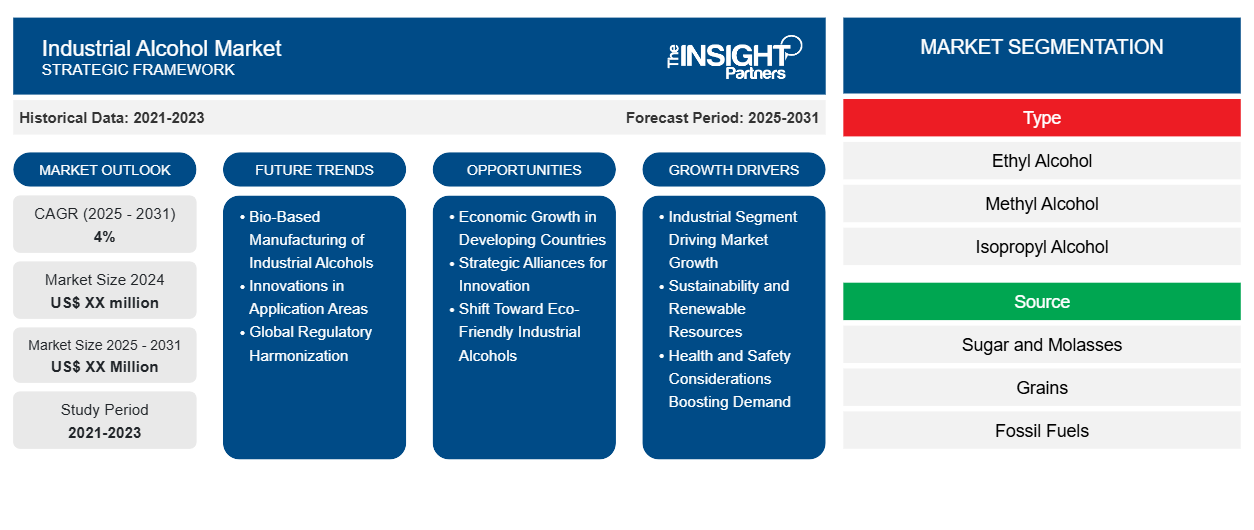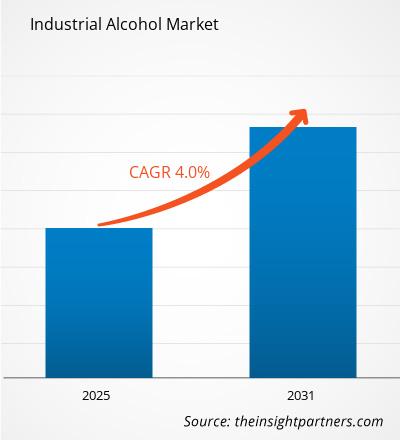Si prevede che il mercato dell'alcol industriale registrerà un CAGR del 4% dal 2023 al 2031, con una dimensione di mercato in espansione da XX milioni di dollari USA nel 2023 a XX milioni di dollari USA entro il 2031.
Il rapporto sul mercato dell'alcol industriale è segmentato per tipo (alcol etilico, alcol metilico, alcol isopropilico e altri). Il mercato è segmentato in base alla fonte (zucchero e melassa, cereali, combustibili fossili e altri). Il mercato è segmentato in base all'applicazione (carburante, cura della persona, prodotti farmaceutici, intermedi chimici e altri). L'analisi globale è ulteriormente suddivisa a livello regionale e nei principali paesi. Le dimensioni del mercato e le previsioni a livello globale, regionale e nazionale per tutti i segmenti di mercato chiave sono coperte nell'ambito. Il rapporto offre il valore in USD per l'analisi, i segmenti, le regioni e i paesi di cui sopra. Il rapporto copre le tendenze di mercato, nonché le dinamiche di mercato come driver, restrizioni e opportunità chiave. Il rapporto copre anche il panorama del settore e l'analisi della concorrenza che copre la concentrazione del mercato, l'analisi della mappa di calore, i principali attori e gli sviluppi recenti nel mercato.
Scopo del rapporto
Il report Industrial Alcohol Market di The Insight Partners mira a descrivere il panorama attuale e la crescita futura, i principali fattori trainanti, le sfide e le opportunità. Ciò fornirà spunti a vari stakeholder aziendali, come:
- Fornitori/produttori di tecnologia: per comprendere le dinamiche di mercato in evoluzione e conoscere le potenziali opportunità di crescita, consentendo loro di prendere decisioni strategiche informate.
- Investitori: condurre un'analisi completa delle tendenze in merito al tasso di crescita del mercato, alle proiezioni finanziarie del mercato e alle opportunità esistenti lungo la catena del valore.
- Enti di regolamentazione: regolamentano le politiche e le attività di controllo sul mercato allo scopo di ridurre al minimo gli abusi, preservare la fiducia degli investitori e sostenere l'integrità e la stabilità del mercato.
Segmentazione del mercato dell'alcol industriale
Tipo
- Alcol etilico
- Alcool metilico
- Alcool isopropilico
Fonte
- Zucchero e melassa
- Grani
- Combustibili fossili
Applicazione
- Carburante
- Cura della persona
- Prodotti farmaceutici
- Intermedio chimico
Geografia
- America del Nord
- Europa
- Asia-Pacifico
- America del Sud e Centro
- Medio Oriente e Africa
Geografia
- America del Nord
- Europa
- Asia-Pacifico
- America del Sud e Centro
- Medio Oriente e Africa
Personalizza questo report in base alle tue esigenze
Riceverai la personalizzazione gratuita di qualsiasi report, comprese parti di questo report, o analisi a livello nazionale, pacchetto dati Excel, oltre a usufruire di grandi offerte e sconti per start-up e università
- Scopri le principali tendenze di mercato in questo rapporto.Questo campione GRATUITO includerà analisi di dati che spaziano dalle tendenze di mercato alle stime e alle previsioni.
Fattori trainanti della crescita del mercato dell'alcol industriale
- Segmento industriale che guida la crescita del mercato: il segmento industriale è uno dei segmenti fondamentali che guidano il mercato globale degli alcolici industriali grazie alla sua ampia applicazione in numerosi settori, tra cui farmaceutico, alimentare e delle bevande, settore della cura della persona, automobilistico e così via. Etanolo, isopropanolo e altri alcolici industriali sono utilizzati dalle industrie per processi di produzione, applicazioni di solventi e come materia prima per la sintesi chimica.
- Sostenibilità e risorse rinnovabili: c'è una crescente attenzione verso la sostenibilità e le risorse rinnovabili nella produzione di alcol domestica e industriale. L'uso di etanolo di origine vegetale, ricavato da colture come mais e canna da zucchero, è ampiamente adottato come combustibile più pulito a causa dei divieti sull'uso di combustibili fossili, grazie a politici e consumatori.
- Considerazioni sulla salute e la sicurezza che stimolano la domanda: le considerazioni sulla salute e la sicurezza imposte dalle autorità di regolamentazione sono un altro fattore che stimola la domanda di alcoli industriali, in particolare nel settore sanitario e igienico-sanitario. Con la necessità di disinfettanti e igienizzanti efficaci che sta diventando un requisito cruciale (in particolare a causa della pandemia di Coronavirus), si è registrato un aumento del consumo e, di conseguenza, della produzione di prodotti contenenti alcol, il che contribuisce a far progredire il mercato.
Tendenze future del mercato dell'alcol industriale
- Produzione di alcoli industriali basata su biotecnologie: è probabile che il movimento verso la produzione di alcoli industriali basata su biotecnologie, come il metil etil chetone, continui. L'emergere di moderne tecniche biotecnologiche abbinate a processi di fermentazione ha favorito la produzione di biodiesel e bioalcoli, rendendoli più economici e produttivi. Questo cambiamento è in linea con le pratiche sostenibili e con il desiderio di ridurre i gas serra.
- Innovazioni nelle aree di applicazione: il mercato dell'alcol industriale cambierà con l'avvento delle innovazioni nelle aree di applicazione, in particolare nei prodotti farmaceutici e nella cura della persona. C'è lo sviluppo di prodotti più efficaci e più facili da usare che incorporano nuove applicazioni e alcol industriali e le tecnologie fornite con questi prodotti. Questi includono sistemi avanzati di somministrazione di farmaci e prodotti per la cura della persona contenenti alcol che fungono da conservanti e migliorano le prestazioni del prodotto.
- Armonizzazione normativa globale: in tutto il mondo vengono istituiti più enti normativi, il che porterà a una maggiore armonizzazione della produzione e dell'uso di alcoli industriali. Questo sviluppo garantirà che i prodotti aderiscano agli aspetti di sicurezza e qualità richiesti e le caratteristiche del mercato relative a questi prodotti cambieranno verso una maggiore domanda di tali prodotti.
Opportunità di mercato dell'alcol industriale
- Crescita economica nei paesi in via di sviluppo: la crescita delle economie dei paesi in via di sviluppo crea un'impennata della domanda per il mercato dell'alcol industriale. La crescita costante dell'industrializzazione, dell'urbanizzazione e l'aumento dei livelli di reddito rendono disponibili una serie di prodotti che contengono principalmente alcol, ad esempio, nell'industria automobilistica, sanitaria e di trasformazione alimentare, tra gli altri settori. Gli investitori in queste aree dovrebbero concentrarsi sul potenziale che deriva dall'ampia crescita.
- Alleanze strategiche per l'innovazione: le organizzazioni di ricerca e sviluppo tecnologico, altre aziende all'interno dello stesso settore e i principali produttori/fornitori di apparecchiature dovrebbero essere coinvolti in alleanze strategiche con l'obiettivo di migliorare l'innovazione e l'offerta di prodotti. Tali sforzi possono portare all'introduzione di nuove applicazioni e processi che possono aumentare la quota di mercato.
- Spostamento verso alcol industriali eco-compatibili: il mercato attuale è alla ricerca di alcol industriali verdi ed eco-compatibili. I prodotti alcolici eco-compatibili e i metodi di produzione sostenibili sono destinati ad attrarre consumatori e aziende che sono eco-compatibili. Questo in considerazione del fatto che le tendenze di produzione e consumo stanno rapidamente cambiando per abbracciare la sostenibilità.
Approfondimenti regionali sul mercato dell'alcol industriale
Le tendenze regionali e i fattori che influenzano il mercato dell'alcol industriale durante il periodo di previsione sono stati ampiamente spiegati dagli analisti di Insight Partners. Questa sezione discute anche i segmenti e la geografia del mercato dell'alcol industriale in Nord America, Europa, Asia Pacifico, Medio Oriente e Africa e America meridionale e centrale.

- Ottieni i dati specifici regionali per il mercato dell'alcol industriale
Ambito del rapporto sul mercato dell'alcol industriale
| Attributo del report | Dettagli |
|---|---|
| Dimensioni del mercato nel 2023 | XX milioni di dollari USA |
| Dimensioni del mercato entro il 2031 | XX milioni di dollari USA |
| CAGR globale (2023-2031) | 4% |
| Dati storici | 2021-2022 |
| Periodo di previsione | 2024-2031 |
| Segmenti coperti | Per tipo
|
| Regioni e Paesi coperti | America del Nord
|
| Leader di mercato e profili aziendali chiave |
|
Densità degli attori del mercato dell'alcol industriale: comprendere il suo impatto sulle dinamiche aziendali
Il mercato dell'alcol industriale sta crescendo rapidamente, spinto dalla crescente domanda degli utenti finali dovuta a fattori quali l'evoluzione delle preferenze dei consumatori, i progressi tecnologici e una maggiore consapevolezza dei benefici del prodotto. Con l'aumento della domanda, le aziende stanno ampliando le loro offerte, innovando per soddisfare le esigenze dei consumatori e capitalizzando sulle tendenze emergenti, il che alimenta ulteriormente la crescita del mercato.
La densità degli operatori di mercato si riferisce alla distribuzione di aziende o società che operano in un particolare mercato o settore. Indica quanti concorrenti (operatori di mercato) sono presenti in un dato spazio di mercato in relazione alle sue dimensioni o al valore di mercato totale.
Le principali aziende che operano nel mercato dell'alcol industriale sono:
- Birla Sugar Ltd.
- Azienda
- Cristalco SAS
- Risorse di Flint Hills
- Società di lavorazione del grano
Disclaimer : le aziende elencate sopra non sono classificate secondo un ordine particolare.

- Ottieni una panoramica dei principali attori del mercato dell'alcol industriale
Punti di forza chiave
- Copertura completa: il rapporto esamina in modo completo i prodotti, i servizi, le tipologie e gli utenti finali del mercato degli alcolici industriali, offrendo una panoramica olistica.
- Analisi degli esperti: il rapporto è compilato sulla base della conoscenza approfondita di esperti e analisti del settore.
- Informazioni aggiornate: il rapporto garantisce la pertinenza aziendale grazie alla copertura di informazioni recenti e tendenze nei dati.
- Opzioni di personalizzazione: questo report può essere personalizzato per soddisfare le esigenze specifiche del cliente e adattarsi in modo appropriato alle strategie aziendali.
Il rapporto di ricerca sul mercato degli alcolici industriali può quindi aiutare a guidare il percorso di decodificazione e comprensione dello scenario del settore e delle prospettive di crescita. Sebbene possano esserci alcune preoccupazioni valide, i vantaggi complessivi di questo rapporto tendono a superare gli svantaggi.
- Analisi storica (2 anni), anno base, previsione (7 anni) con CAGR
- Analisi PEST e SWOT
- Valore/volume delle dimensioni del mercato - Globale, regionale, nazionale
- Industria e panorama competitivo
- Set di dati Excel



Report Coverage
Revenue forecast, Company Analysis, Industry landscape, Growth factors, and Trends

Segment Covered
This text is related
to segments covered.

Regional Scope
North America, Europe, Asia Pacific, Middle East & Africa, South & Central America

Country Scope
This text is related
to country scope.
Domande frequenti
Bio-based alcohol production is expected to be the key market trends.
Based on geography, Asia Pacific held the largest share of the industrial alcohol market due to its growing industrial sector, personal care and pharmaceuticals industry.
Based on application, the pharmaceuticals segment is expected to witness the fastest growth during the forecast period.
The increasing demand from various industries is driving the market growth.
Cargill Incorporated, Merck KGaA, Green Plains Inc, Cristalco, The Andersons Inc, Grain Processing Corporation, GREENFIELD GLOBAL INC, BASF SE, BirlaSugar, and LyondellBasell Industries Holdings B.V. are the key players operating in the industrial alcohol market.
The Industrial Alcohol Market is estimated to witness a CAGR of 4% from 2023 to 2031
Trends and growth analysis reports related to Chemicals and Materials : READ MORE..
1. Birla Sugar Ltd.
2. Cargill, Inc.
3. Cristalco SAS
4. Flint Hills Resources
5. Grain Processing Corporation
6. Green Plains Inc.
7. Greenfield Specialty Alcohols
8. MGP Ingredients
9. Sigma Aldrich
10. The Andersons Inc.
The Insight Partners performs research in 4 major stages: Data Collection & Secondary Research, Primary Research, Data Analysis and Data Triangulation & Final Review.
- Data Collection and Secondary Research:
As a market research and consulting firm operating from a decade, we have published and advised several client across the globe. First step for any study will start with an assessment of currently available data and insights from existing reports. Further, historical and current market information is collected from Investor Presentations, Annual Reports, SEC Filings, etc., and other information related to company’s performance and market positioning are gathered from Paid Databases (Factiva, Hoovers, and Reuters) and various other publications available in public domain.
Several associations trade associates, technical forums, institutes, societies and organization are accessed to gain technical as well as market related insights through their publications such as research papers, blogs and press releases related to the studies are referred to get cues about the market. Further, white papers, journals, magazines, and other news articles published in last 3 years are scrutinized and analyzed to understand the current market trends.
- Primary Research:
The primarily interview analysis comprise of data obtained from industry participants interview and answers to survey questions gathered by in-house primary team.
For primary research, interviews are conducted with industry experts/CEOs/Marketing Managers/VPs/Subject Matter Experts from both demand and supply side to get a 360-degree view of the market. The primary team conducts several interviews based on the complexity of the markets to understand the various market trends and dynamics which makes research more credible and precise.
A typical research interview fulfils the following functions:
- Provides first-hand information on the market size, market trends, growth trends, competitive landscape, and outlook
- Validates and strengthens in-house secondary research findings
- Develops the analysis team’s expertise and market understanding
Primary research involves email interactions and telephone interviews for each market, category, segment, and sub-segment across geographies. The participants who typically take part in such a process include, but are not limited to:
- Industry participants: VPs, business development managers, market intelligence managers and national sales managers
- Outside experts: Valuation experts, research analysts and key opinion leaders specializing in the electronics and semiconductor industry.
Below is the breakup of our primary respondents by company, designation, and region:

Once we receive the confirmation from primary research sources or primary respondents, we finalize the base year market estimation and forecast the data as per the macroeconomic and microeconomic factors assessed during data collection.
- Data Analysis:
Once data is validated through both secondary as well as primary respondents, we finalize the market estimations by hypothesis formulation and factor analysis at regional and country level.
- Macro-Economic Factor Analysis:
We analyse macroeconomic indicators such the gross domestic product (GDP), increase in the demand for goods and services across industries, technological advancement, regional economic growth, governmental policies, the influence of COVID-19, PEST analysis, and other aspects. This analysis aids in setting benchmarks for various nations/regions and approximating market splits. Additionally, the general trend of the aforementioned components aid in determining the market's development possibilities.
- Country Level Data:
Various factors that are especially aligned to the country are taken into account to determine the market size for a certain area and country, including the presence of vendors, such as headquarters and offices, the country's GDP, demand patterns, and industry growth. To comprehend the market dynamics for the nation, a number of growth variables, inhibitors, application areas, and current market trends are researched. The aforementioned elements aid in determining the country's overall market's growth potential.
- Company Profile:
The “Table of Contents” is formulated by listing and analyzing more than 25 - 30 companies operating in the market ecosystem across geographies. However, we profile only 10 companies as a standard practice in our syndicate reports. These 10 companies comprise leading, emerging, and regional players. Nonetheless, our analysis is not restricted to the 10 listed companies, we also analyze other companies present in the market to develop a holistic view and understand the prevailing trends. The “Company Profiles” section in the report covers key facts, business description, products & services, financial information, SWOT analysis, and key developments. The financial information presented is extracted from the annual reports and official documents of the publicly listed companies. Upon collecting the information for the sections of respective companies, we verify them via various primary sources and then compile the data in respective company profiles. The company level information helps us in deriving the base number as well as in forecasting the market size.
- Developing Base Number:
Aggregation of sales statistics (2020-2022) and macro-economic factor, and other secondary and primary research insights are utilized to arrive at base number and related market shares for 2022. The data gaps are identified in this step and relevant market data is analyzed, collected from paid primary interviews or databases. On finalizing the base year market size, forecasts are developed on the basis of macro-economic, industry and market growth factors and company level analysis.
- Data Triangulation and Final Review:
The market findings and base year market size calculations are validated from supply as well as demand side. Demand side validations are based on macro-economic factor analysis and benchmarks for respective regions and countries. In case of supply side validations, revenues of major companies are estimated (in case not available) based on industry benchmark, approximate number of employees, product portfolio, and primary interviews revenues are gathered. Further revenue from target product/service segment is assessed to avoid overshooting of market statistics. In case of heavy deviations between supply and demand side values, all thes steps are repeated to achieve synchronization.
We follow an iterative model, wherein we share our research findings with Subject Matter Experts (SME’s) and Key Opinion Leaders (KOLs) until consensus view of the market is not formulated – this model negates any drastic deviation in the opinions of experts. Only validated and universally acceptable research findings are quoted in our reports.
We have important check points that we use to validate our research findings – which we call – data triangulation, where we validate the information, we generate from secondary sources with primary interviews and then we re-validate with our internal data bases and Subject matter experts. This comprehensive model enables us to deliver high quality, reliable data in shortest possible time.


 Ottieni un campione gratuito per questo repot
Ottieni un campione gratuito per questo repot